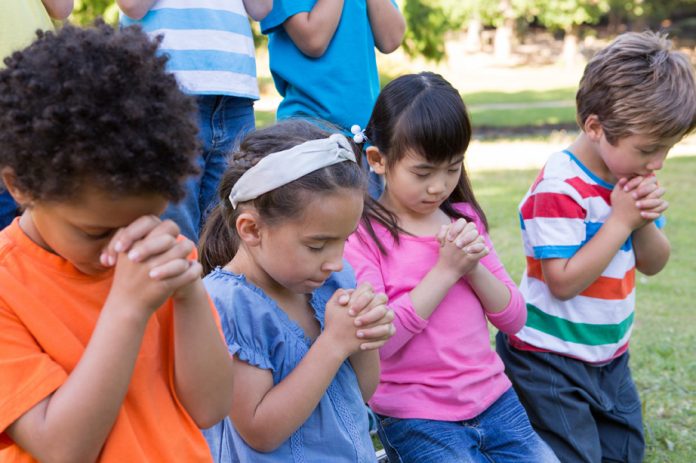
April-May 2017
As a 2nd grade catechist I have found that it is so important to be prepared and have everything ready for each lesson. I have also found that it is equally important, maybe more so, to sometimes deviate from the plan that I worked so hard to prepare. Being flexible and allowing the Holy Spirit to work in your classroom, is when the best lessons occur. For example, one time we were reading the story of when Jesus wept when Lazarus died. (John 11:35) We talked about the fact that just like us, Jesus was sad sometimes. One shy little girl raised her hand to tell me that she was feeling very sad. Instead of continuing with my planned lesson, I took the time to allow this little girl, and other students to talk about the things that made them sad. We then prayed together and asked God to comfort all of us. There is no doubt in my mind that this was the lesson that needed to be taught, not the one that I had planned!
– Suzy W., catechist, Lexington, KY
March 2017
LEARN!! Talk to other catechists and exchange ideas. Don’t limit yourself to your own classroom.
Attend local catechetical gatherings or religious education conferences. There’s a difference between meeting and exchanging ideas and experiences in person, rather than searching the internet for a lesson plan. Nothing compares with meeting others and finding inspiration. Remember, you might also be a source of inspiration to another catechist!
– Donna R., Wood-Ridge, New Jersey
February 2017
When acting out bible stories, or other things, like demonstrations of the sacraments, keep a supply of hats in the class to use as easy costume props. These costumes help the children to get into their roles more, and when they do, the acting becomes more realistic. (It also helps them remember who is who in the scenario.)
–Faye, J. catechist, Port Tobacco, Maryland.
January 2017
Before your students arrive, place a task on the tables that relates to the theme of the day.
It will immediately attract their interest and help them transition from the noisy world outside to your lesson. It also gives you breathing room to take attendance. Word searches, Catholic trivia quizzes, mazes, and crossword puzzles are good icebreakers … and can be created free online.
–Lisa Mladinich
November 2016
Read through the lesson ahead of time and let it “marinate.” Give thought to how the lesson can be presented in a way meaningful to your students. Live each moment as if God is living it with you … because he is.
–Kristi L., catechist, St. Charles, Illinois
October 2016
Never hesitate to draw from your personal stories. It makes your faith real to others.
—Barbara F. Thibodaux, LA
June 2016
To prepare children for their first holy Communion — make a little book to use at home like St. Therese’s older sister had her do before her first holy Communion. The book’s pages could be in many colors and decorated with flower stickers. Each day St. Therese offered Jesus the flowers of her sacrifices.
— Pauline M., catechist, Oakbrook Terrace, Illinois
May 2016
Try to relate lessons to your students’ daily lives. Tailor lessons to the age group you are teaching, and try to make it as interesting as possible for them whether it is with games or skits or even just group discussions.
— Ryan B., catechist, Evansville, Indiana
April 2016
No matter what the age level you are teaching, get down to the level of the students. Young children are not going to learn from a teacher who acts like they are going to teach a lecture series. Get on their level and make it fun but make it relate to their lives as well. Our religion should be a way of life and it’s our responsibility to show them that way of life. I would like to add that if you asked my youth what tip I should share, they would probably say my end-of-the-year survey I have my youth complete. My survey has only a few questions.
The question are:
What did you like best about this year?
What did you like least about this year?
What did you learn that you didn’t know before?
How do you feel about the teacher?
It is amazing what you learn and I use this information to help me plan the next year to try and make each year even more successful.
— Maureen W., catechist, Oswego, N.Y.
March 2016
Preschool-age children are very visual and learn from what is around them as well as participating in activities. Whatever the lesson of the week is, I set up a display on the table so it is the first thing they see when they walk in. For example, one week I had masks and beads for discussion of Fat Tuesday / Mardi Gras and the next week I introduced the color purple for discussion of the season of Lent. Activities for learning will be centered around art projects and music. The attention span for 4-year-olds is short so we keep the class moving from one activity to the next in blocks of 10-15 minutes.
— Judy S., catechist, Boone, N.C.
February 2016
Each year, our youth group creates a “Cardboard City” in which the members sleep outside through the night in a box to experience what it is like to be homeless. We have guest speakers who were previously homeless speak about their experiences. We also have various exercises throughout the night to learn about the poor throughout the world. During one such exercise, we provide each member a new identity and ask him or her to imagine what it is like to be a refugee from a country that is in the midst of a civil war. They had to learn to live with only what they could carry on their backs and decide what was really necessary for their survival. After that experience, the members reflected on the things that they take for granted living in the United States. They now have an expanded world vision of how others live.
— MaryBeth L., parish catechetical leader, Alpha, N.J.
January 2016
Arrange the room you are teaching in so that it is not a classroom type setting — gather around a long table or arrange desks in a circle. Children spend enough time in school. To engage them more, make them feel that their lessons are discussions rather than have their noses stuck in a book. Engage them to share their opinions and experiences. For the younger ones, break up the lessons with a craft that relates to that day’s teaching.
— Erica P., catechist (grade 7), Wood Ridge, N.J.
Find the Jesus in all the children even when it does not show.
— Carol S., catechist, Wayzata, MN
December 2015
One teaching tip is to use the Pflaum Gospel Weeklies and have the children read the parts aloud. By doing this, it reinforces the Gospel to the children and it makes the Gospel story come alive. Almost as if they are acting it out.
— Catherine S., catechist (grades 4 and 5), Hampton Bays, N.Y.
November 2015
Keeping elementary-aged kids engaged during an entire class can be challenging. I like to prepare a craft or simple activity for each lesson that relates back to the theme we are learning. Sometimes it can be as simple as having them draw a picture and then writing a short prayer saying what they are thankful for. This portion of the class gives them a chance to be creative while reflecting on what they have learned. As a bonus — at the end of class — they have something to show their parents and they feel proud of what they have accomplished.
— Waleska S., catechist (grade 4), Phoenix, AZ
August 2015 CATECHIST Tip of the Month
During Lent, it is often difficult for young people to remember the three spiritual practices they choose of prayer, fasting, and almsgiving. I take purple foam found in a craft store and cut it into the shape of a door hanger like the “Do Not Disturb” signs hung on hotel room doors. I have the students write out their fasting practices around the hole for the door knob. In the middle, they write their form of prayer and finally near the bottom, what type of almsgiving for the poor they choose to participate in. They decorate them with markers and religious symbols of Lent. Students take them home to hang on the doors of their bedrooms for a quick reminder of their Lenten practices.
— Julie W., catechist (grades 6, 7, 8), Glen Ellyn, IL
July 2015 CATECHIST Tip of the Month
In an effort to remind my students to look for Jesus in their lives, each session I hide a small crucifix somewhere in the room before students arrive. As the students enter, they immediately begin looking for Jesus. When they find the crucifix, I challenge them to discover why Jesus would be in that location. What message is he sending them? Responses vary. For example, when the crucifix was at the computer, students suggested that Jesus was reminding them to be careful when using the Internet.
— Mariann A., catechist (grade 7), Haworth, N.J.
June 2015 CATECHIST Tip of the Month
I believe the most important tip I can offer is to really love the children you teach. Then, everything else will fall into place.
— Dianne P., catechist (ages 4, 5, and 6), first reconciliation and first Communion (ages 7 and 8), Andover, KS
October 2014 CATECHIST Tip of the Month
My fifth-graders and I meet only once a week, and so during the first class time in October, I set the scene—literally—for the celebration of All Saints and the Communion of Saints. When the kids get to class that first class time in October, they will see that our prayer table has been replaced by a long table covered in white (butcher) paper. On the paper, I will have drawn plain placements (plain rectangles about 12” tall and 18” wide—enough for each child in the class to have his or her own “placement;” the placemats might be larger is space permits) all around the edge of the table, as if the table were getting read to be “set” for a meal. My lesson for that first class time in October is about the saints and the Communion of Saints. Before the end of that class time, the kids will go to the table and “pick” a placemat that they will decorate, just a little at a time, at each class time during October. They can draw and color anything they want on their placemats—names, symbols, words, pictures—that has to do with the saints and the Communion of Saints. At the last class time in October, I remind the kids of All Saints Day on November 1 and All Souls Day on November 2, and we pull chairs up to the table and have a feast (wholesome snacks) in honor of the saints and the Communion of Saints.
—Barbara S. Fifth-grade catechist
September 2014 CATECHIST Tip of the Month
I teach fourth-graders. I know how important it is to set the tone for the coming year, so right at the beginning of class at the first class of the year, I do my “First Day Commercial” to capture the kids’ interest and generate enthusiasm right off the bat. I ask: “What is the date we celebrate Jesus’ birth?” Of course, everyone knows: December 25—and they all call it out. Then I ask: “What is the name of the prayer we pray in honor of Mary?” Of course, everyone knows: the Hail Mary—and they all call it out, too. Then I ask: “On what date do we celebrate Jesus being conceived in Mary’s womb?” The room is totally silent; no one ever knows that answer. Then I ask in quick sequence, not waiting for answers: “What is the date we celebrate Mary’s birthday? What feast do we celebrate on New Year’s Day? What is the Triduum? Why do we genuflect in church? What is the liturgical year? What are the names of the archangels? When did you last go to confession?” And then I catch a breath and, of course, the room is still total quiet. Then I slowly say, “Well, that just goes to show that there is a lot to learn about our wonderful Catholic faith, doesn’t it. We are going to learn the answers to those questions and so much more this year! And you will learn more about how Jesus is your BFF. So let’s get started!” And then I move right into my lesson plan, from the first section of the textbook. I don’t even do all the housekeeping details that have to be taken care of on that first day until the end of class..
—Ellory L., Fourth-grade catechist
August 2014 CATECHIST Tip of the Month
I did something during the third class I taught—that’s been 10 years—and I continue to do it. I included a “Picture This” component to the lesson plan. This involves a group of students working to draw a picture or a symbol that represents a key point in the lesson. They draw on a large piece of poster board that fits perfectly on top of a large framed print that I bought at a second-hand store the first year my husband and I were married (nearly 25 years ago). I use some hanging putty to hold the poster board in place on top of the old print inside the frame. The kids take such pains to make their artistic expression presentable because I leave it up for several weeks. The kids often ask, “Can we do ‘Picture This’ today?” This year, I’m going to use my “Picture This” frame to present a WELCOME TO A NEW YEAR greeting for the first day of class.
—Merrideth R.
July 2014 CATECHIST Tip of the Month
During our VBS program last year, I introduced Love Links—and the activity was great. I’m going to do Love Links again this year. This is how it works: On the first day of VBS, each child gets a packet of Love Links. It’s a small booklet of six slips of paper (about the size of a dollar bill) stapled together at one of the short ends. Each piece of paper in the packet is designed like a miniature certificate with these words: “To ________ for showing others the love of Jesus in the way you ____________. Thank you for helping me learn about Jesus and our Catholic faith. From ___.” (I make sure the blanks are long.) Throughout the week, each child eventually completes (and delivers) every Love Link in his or her booklet to another child. The child will have thanked six different people for showing others the love of Jesus in specific ways. Each time a child receives a Love Link, he or she gives it to our VBS Captain who adds it to a paper chain of Love Links that is draped across the front of the altar in church. The Chain of Love grows longer and longer throughout the week so that it makes for a beautiful visual and symbolic trimming of the altar at our closing Mass on the last day.
—Julie T., VBS Coordinator
June 2014 CATECHIST Tip of the Month
I’ve been a DRE for 17 years. I’ve seen a lot of changes during that time. The main change: in me! The years have taught me to be more open and collaborative. It’s not MY PROGRAM and they are not MY CATECHISTS! One of the ways I keep myself open and collaborative is to send an email to every catechist in the program at the end of the year and ask him/her to answer three questions:
What can I do to improve our faith formation program for the good of everyone involved?
What can you do to improve our faith formation program for the good of everyone involved?
What can we do together to improve our faith formation program for the good of everyone involved?
The ideas that surface are insightful and creative, and they have improved the program immeasurably over the years. Plus…most important…the sense of unity that is built in this exercise could not happen in any other way.
—Always Learning DRE
May 2014 CATECHIST Tip of the Month
As our parish DRE, I make a point to visit each learning space to observe my catechists in action and to get to learn the children’s names. During those visits, I find the most innovative ideas for sharing the faith. I keep wishing that there were some way to share these great things with others. So this year, I have asked each catechist to reflect back on their most successful and creative efforts and to submit them to this very Tip of the Month site. I have enjoyed seeing the catechists’ reflective and quite humble submissions.
—Lori Crawford, Ft. Myers, FL .
April 2014 CATECHIST Tip of the Month
This is not a tip about something I did. Rather, it’s about what I plan to do during April this year, praying that it works. Blessed Pope John XXIII and Blessed Pope John Paul II will be canonized on April 27. My eighth-graders are old enough to remember Pope John Paul II and, as part of their Church history, they need to appreciate the important role that Pope John XXIII played in the Second Vatican Council. And so each time our group meets during the month of April, every student needs to present three facts: one fact about Blessed Pope John XXIII; one fact about Blessed Pope John Paul II; and one fact about the canonization process, in general or this particular canonization celebration in particular. Students can get their facts from books, the diocesan paper, or the net. Even if there are duplicate facts, we still will gather a lot of information about the canonization and so be better prepared to understand and appreciate the faith of these beautiful saints and the historic meaning of their canonizations.
—Vicki A.
March 2014 CATECHIST Tip of the Month
Each March, I plan a lesson and a project around St. Joseph, whose feast day is celebrated on March 19. I teach sixth-graders and so we talk about the reference to Jesus as the son of the carpenter…and that would be Jesus (Matthew 13:53-5). We talk about some of the things that Joseph might have made and the carpenter services that Joseph could offer others. Then I divide the class into three groups. One group comes up with lyrics to a song they write about Joseph, using the tune of a popular song that each person in the group agrees on. A second group writes a prayer to St. Joseph. The third group writes a very simple story presenting the life of St. Joseph. Then we “practice” each of these things (the song, the prayer, and the story) and when we feel good about each part, I arrange for my sixth-graders to make a presentation on St. Joseph to a group of younger students. We start with the story, then my students teach the younger kids the song, and we close with the prayer. It’s a great learning experience for everyone—and it’s great fun!
—Sarah D.
February 2014 CATECHIST Tip of the Month
The feast of Our Lady of Lourdes is February 11. Each year I do research to come up with something to share with my fourth-graders about Our Lady of Lourdes or St. Bernadette Soubirous. I think it’s especially important for kids today to know about St. Bernadette because her family struggled financially, she was a teenager when Mary appeared to her, and she had to face people who wouldn’t believe that she had seen Mary. I’ve been a catechist for seven years; I teach fourth grade. The kids find the story of Our Lady of Lourdes and St. Bernadette Soubirous really interesting so the week of February 11, I give the kids titles of books, websites, prayers, and images that encourage their interest..
—Charles L.
January 2014 CATECHIST Tip of the Month
Children of all ages do not know what we celebrate on January 1. It’s one of our holy days of obligation, yet few children, no matter how old they are, cannot offer even a simple explanation of the name of the holy day and who we honor in a special way on that day and why. So before my students (fifth-graders) return to class in January, I arrange a Mary table in our prayer space. I drape the table with a real pretty blue cloth. I put a statue of Mary on the table, along with an electric candle, a small nosegay (from a dollar store), and a rosary. Each of the remaining weeks during January, I extend the time of our closing prayer (by five minutes) to allow for some brief catechetical comments about Mary and to pray a decade of the Rosary.
—Elmyra S., catechist for eight years
December 2013 CATECHIST Tip of the Month
It’s a very simple thing to do…make hand-made greeting cards for your students. Oh, yes. I know. It’s time-consuming. But keep it as simple as you can and you’ll find that it’s so worth the time and effort that it takes. I just buy a box of religious Christmas cards at one of those everything-is-a-dollar kind of stores. I cut off the front of each card and then glue the inside greeting to the back of the front. Then I write a short personal message to the student at the bottom of the printed greeting. Then I cover the whole thing—back and front—with clear contact paper. I punch a hole in the top of it and slip a decorative ribbon through the hole and tie a knot so the child can hang the greeting on his/her Christmas tree. I’ve been doing this for seven years with my fourth-graders and very few of the children come back from Christmas break without a huge “Thank you for your Christmas card.”
—T. D., San Antonio, TX
November 2013 CATECHIST Tip of the Month
This project is meant for November to celebrate the Feast of All Saints. The week before the Feast of All Saints, we have the children in the religious education program at Holy Spirit Catholic Church work on a saint project. We give each child a cutout gingerbread-style person, and we also assign them the name




